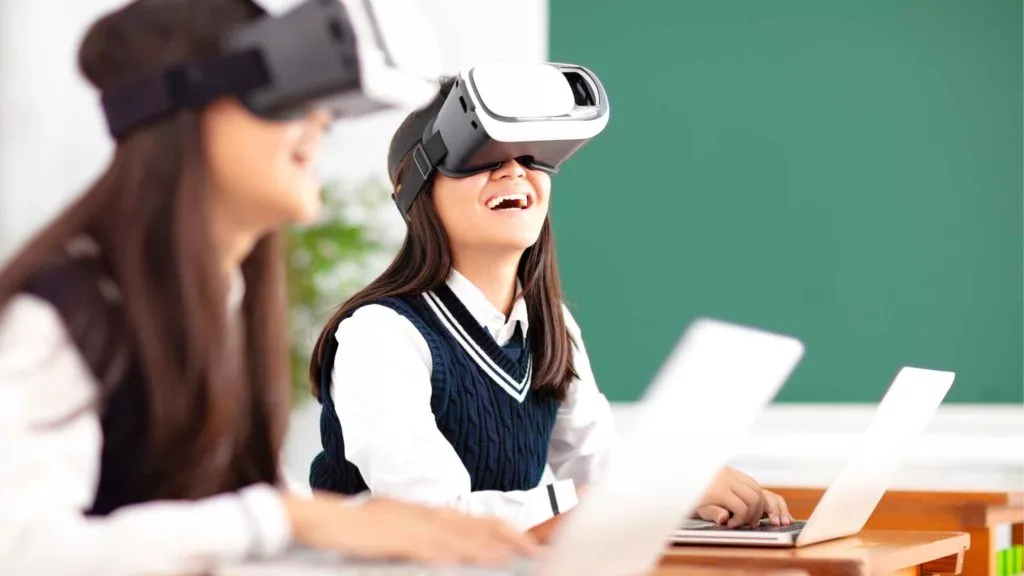Imagine a classroom where students can explore ancient civilizations, journey through the human body, or even experience simulations of real-world events. This is the future of education, and it's all thanks to virtual reality technology.
With virtual reality, students can immerse themselves in new and exciting worlds that were previously impossible to explore. They can learn through visualizations and simulations that are more engaging, interactive and memorable than traditional teaching methods.
One of the major advantages of virtual reality in education is the ability to provide outstanding visualizations that are not possible in the traditional classroom. For example, students can experience a virtual field trip to a historical site or a simulation of a scientific process and experience outdoor education. This allows students to gain a deeper understanding and retain the information better.
Let’s deep dive into it.

Unlocking the potential of virtual reality in the classroom: Advantages of VR in education
“Virtual reality technology is revolutionizing the way we educate future generations. With VR, students can explore ancient civilizations, visit distant planets, and even perform virtual surgeries, all from the comfort of their classroom”, says Mike Owens, Digital Marketing & Growth Director at HostingRevelations.
This immersive and interactive learning experience brings subjects to life in a way that traditional methods cannot.
One of the major advantages of virtual reality in education is the ability to provide outstanding visualizations that are not possible in the traditional classroom. For example, students can experience a virtual field trip to a historical site or a simulation of a scientific process. This allows students to gain a deeper understanding and retain the information better.
Another advantage is the ability to create interest and increase student engagement. VR technology is exciting and students are more likely to be engaged and motivated to learn when they are experiencing it. They can interact with the virtual world and interact with the subject in a way that traditional methods cannot.
As Jake Smith, Founder of Personalized Number Plates, says, “Virtual Reality makes learning more enjoyable and less like work. When students are having fun, they are more likely to retain information and be more ambitious.”
Additionally, Virtual Reality improves the quality of education in different fields. For example, VR can be used for medical education to provide students with hands-on experience without the need for live patients. It can also be used in history classes to bring historical sites to life and provide a more immersive experience.
As we asked Lisa Johnson, Editor-in-Chief at Geeks Health about the possible applications of VR into classrooms, she said, “One of the most notable examples of virtual reality technology in the classroom is the use of VR in science education. With VR, students can explore and interact with the virtual world of science in a way that is not possible in the traditional classroom. Students can virtually dissect a frog or explore the inside of a cell. This allows them to gain a deeper understanding and retain the information better.”
Furthermore, virtual reality in science education can also enhance the learning experience in other ways.
For instance, it can provide students with safe and controlled environments to perform experiments that might be too dangerous or expensive to do in real life, such as studying the effects of a volcanic eruption or a nuclear meltdown.
Also, students can explore the solar system, visit other planets, and learn about galaxies and stars.
Moreover, virtual reality can also be used in geography classes to provide students with virtual field trips, which can be a great way to explore historical sites, natural landmarks, and distant locations that might be otherwise difficult or impossible to visit.
In addition to science and geography, virtual reality can be applied in other subjects such as history, literature, and languages. We asked Leo Ye, Forbes 30U30 member and co-founder and CEO of CUBO about it, and this was the reply: “Students can visit historical sites such as the pyramids of Egypt, the Great Wall of China, or the Roman Colosseum, and experience them in a way that is not possible with traditional methods. Or they can read a book and explore the settings of the story, or practice speaking a foreign language in an immersive environment.”
Virtual reality in the classroom: An in-depth look at the current state and future potential
“Virtual Reality (VR) technology is making its way into classrooms and is revolutionizing the way we educate future generations. The use of VR in education provides an immersive and interactive experience for students, allowing them to engage in simulations and virtual experiences that were once impossible in traditional classroom settings”, says Tom Miller, Director of Marketing at Fitness Volt.
Currently, virtual reality technology is being used in a variety of ways in the classroom, including virtual field trips to historical sites, virtual dissections in science classes, and simulations of real-world scenarios in subjects such as engineering and architecture.
For example, Google Expeditions is a program that allows students to explore virtual reality field trips to places such as the Great Wall of China, the International Space Station, and even the depths of the ocean.
Another example is the use of VR simulations in medical and nursing education, where students can practice procedures and surgeries in a safe and controlled environment.
Gene Fitzgerald, Head of Marketing at BOS, puts it this way: “The use of virtual reality in education not only makes learning more interactive and engaging, but it also has the potential to improve the quality of education in various fields. Students can now experience things that were once impossible, such as visiting ancient historical sites and walking through a virtual museum.”
This technology also allows for more personalized learning, as students can interact with the material at their own pace and level.
However, Jonathan Merry, CEO & Founder of Moneyzine, said, “While virtual reality technology has the potential to revolutionize the way we educate future generations, it is still a relatively new technology in the classroom and there is a need for further research and development. The cost of VR equipment and lack of accessibility remains a challenge, as not every school or institution can afford to purchase VR equipment.”
Also, some educators may struggle with incorporating virtual reality into their curriculum and may require additional training to fully utilize the technology. Which leads us to next point.
Current challenges associated with implementing virtual reality into classrooms
As with any new technology, there are challenges that come with implementing virtual reality into virtual classrooms. Sean Stevens, Director of Immerse Education, says “One of the main challenges is the cost of VR equipment and lack of accessibility. The cost of VR headsets, computers and other equipment is quite high and not every school or institution can afford to purchase them.”
Also, there is a shortage of VR content that is tailored to education and limited resources for teachers to access and utilize.
Another challenge is the lack of training and support for educators. Many teachers may struggle with incorporating virtual reality into their curriculum and may require additional training to fully utilize the technology. They may also need help in identifying the right virtual reality resources and activities that align with their curriculum and learning objectives.
When talking about the challenges associated with VR in classrooms, Miriam Domer, Content Marketer at Legal Finders raised an important issue: “A significant challenge is the potential for virtual reality to distract students and decrease focus on traditional learning methods. It's critical for educators to find the right balance between utilizing virtual reality technology and traditional learning methods to ensure that students are still getting the education they need, and not getting distracted.”
Lastly, there is a need for further research and development in virtual reality education. It's important to understand how virtual reality technology affects student learning and how to effectively implement it into the classroom.
To overcome these challenges, schools and educators need to be provided with the necessary resources and support to effectively implement virtual reality technology into the classroom. This includes providing training, support, and access to VR equipment and content that is tailored to education.

5 Ways to engage learners in VR classrooms
One of the key benefits of virtual reality technology in the classroom is the ability to engage learners in new and interactive ways. Here are some ways to maximize engagement in VR classrooms:
Create interactive experiences: Virtual reality technology allows for interactive experiences that can't be replicated in traditional classroom settings. For example, students can explore historical sites, take virtual field trips, and interact with simulations in real-world scenarios. These immersive experiences can spark curiosity and interest in students, making them more engaged in the learning process.
Make it hands-on: VR technology allows students to participate in activities, rather than just observing. This can help students retain information better and feel more engaged in the learning process. For example, instead of just reading or watching videos about dissecting a frog, students can participate in a virtual frog dissection, which can help them understand the anatomy and internal organs of the frog in a more interactive way.
Personalize learning: By using virtual reality, students can interact with the material at their own pace and level. This can help to personalize the learning experience and cater to the needs of individual students. For example, students who struggle with a particular concept can spend more time in virtual simulations, allowing them to practice and master the concept.
Encourage collaboration: VR technology can be used to encourage collaboration among students. For example, students can work together in virtual teams to complete a project or solve a problem, which can help them develop teamwork and communication skills.
Incorporate formative assessments: Teachers can use virtual reality technology to incorporate formative assessments into their lessons. This can help teachers track student progress, provide feedback and adjust instruction accordingly. For example, teachers can use VR quizzes and games to assess student understanding and provide feedback on areas of improvement.
Incorporate these strategies to educate and engage learners in VR classrooms and help them fully benefit from the immersive and interactive experience that virtual reality technology provides.
The final say
Virtual reality technology has the potential to revolutionize the way we educate future generations. It provides an immersive and interactive experience for students, allowing them to engage in simulations and virtual experiences that were once impossible in traditional classroom settings. However, there are challenges associated with implementing virtual reality into classrooms such as cost, lack of accessibility and training, and concerns about its impact on traditional learning methods.
To fully realize the potential of virtual reality in education, address these challenges through providing resources, support, and training for educators, as well as continuing to conduct research and development in the field.


